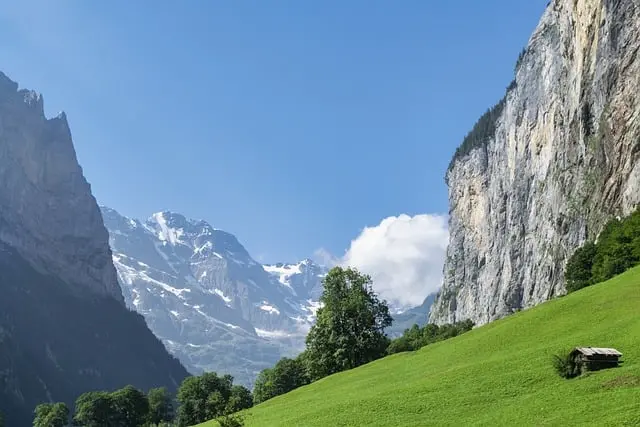
Rothorn—Sunnegga
• Hiking Duration: Approximately 4 hours
• Transportation Options:
Zermatt → Blauherd (Take the cable car from the Rothorn VS station in Zermatt to Blauherd, the starting point of the Five Lakes Trail) → Sunnegga.
• Why It’s Recommended:
This is the famous Five Lakes Trail, a 7.5 km path connecting five stunning alpine lakes—Stellisee, Grindjisee, Grünsee, Mosjesee, and Leisee. The route descends gently most of the way, with only a short steep section at the end. Stellisee is the most beautiful of the five lakes, offering perfect reflections of the Matterhorn on calm, cloudless days. Along the trail, the Matterhorn’s striking triangular profile is a constant companion, nestled between two evenly tall mountain ranges. Fun fact: the iconic Toblerone chocolate shape was inspired by this view of the Matterhorn!
• Tips:
The hike is long, so consider bringing trekking poles if you have low stamina.
Schwarzsee—Zermatt
• Hiking Duration: Approximately 4–5 hours
• Transportation Options:
• Option 1: Matterhorn Glacier Paradise → Schwarzsee (After visiting Matterhorn Glacier Paradise, take the cable car down to Schwarzsee and begin your hike to Zermatt).
• Option 2: Matterhorn Glacier Paradise → Schwarzsee → Furi (Take the cable car from Schwarzsee to Furi and start hiking to Zermatt from there).
• Why It’s Recommended:
This 9.5 km route offers varied mountain scenery and crisp alpine air, perfect for those with good stamina. For a shorter option, take the cable car from Schwarzsee to Furi and hike just 1.5 hours through picturesque mountain villages. The shorter route offers a more relaxed experience.
Rotenboden—Riffelberg
• Hiking Duration: Approximately 1.5 hours
• Transportation Options:
Take the Gornergrat Railway to Rotenboden (second-to-last station) and start your hike.
• Why It’s Recommended:
This is one of the easiest and most popular hiking trails in the Zermatt area, frequently included in guided tours. The views of the Matterhorn are breathtaking, especially in the morning when the calm lake reflects the peak like a mirror. Along the trail, you’ll pass two Riffel Lakes. The first is just a 5-minute walk from Rotenboden, while the second is 10–15 minutes farther and offers an even closer view of the Matterhorn. The second lake, with its aquatic plants and vibrant colors, is particularly stunning.
Gornergrat—Rotenboden
• Hiking Duration: Approximately 1 hour
• Transportation Options:
Walk from Gornergrat Station to Rotenboden along the railway tracks, with some steep inclines.
• Why It’s Recommended:
This trail overlaps with the Rotenboden—Riffelberg route but features a unique highlight: the Ice Lake, nicknamed “The Eye of God.” The lake remains frozen until July and is especially striking on cloudy days. On sunny days, its blue reflections are less dramatic but still captivating.
• Tips:
Avoid this route in summer when the ice melts, as the scenery loses its charm.
Sunnegga—Zermatt
• Hiking Duration: Approximately 2.5 hours
• Transportation Options:
Take the funicular to Sunnegga Station and start your hike from Leisee, just below the station. Walk to Zermatt.
• Why It’s Recommended:
This 4.7 km route is easy, accessible, and well-connected to public transportation. Along the way, you’ll enjoy serene alpine landscapes, charming villages, and vibrant wildlife, including the chance to spot marmots in their natural habitat.
Conclusion
Whether you’re a casual visitor or an experienced hiker, Switzerland has something to offer. Feeling inspired yet? For independent travelers, purchasing a Swiss Pass is highly recommended. It provides half-price discounts on public transport (trains, buses, ferries, and some cable cars), making it a cost-effective choice.
